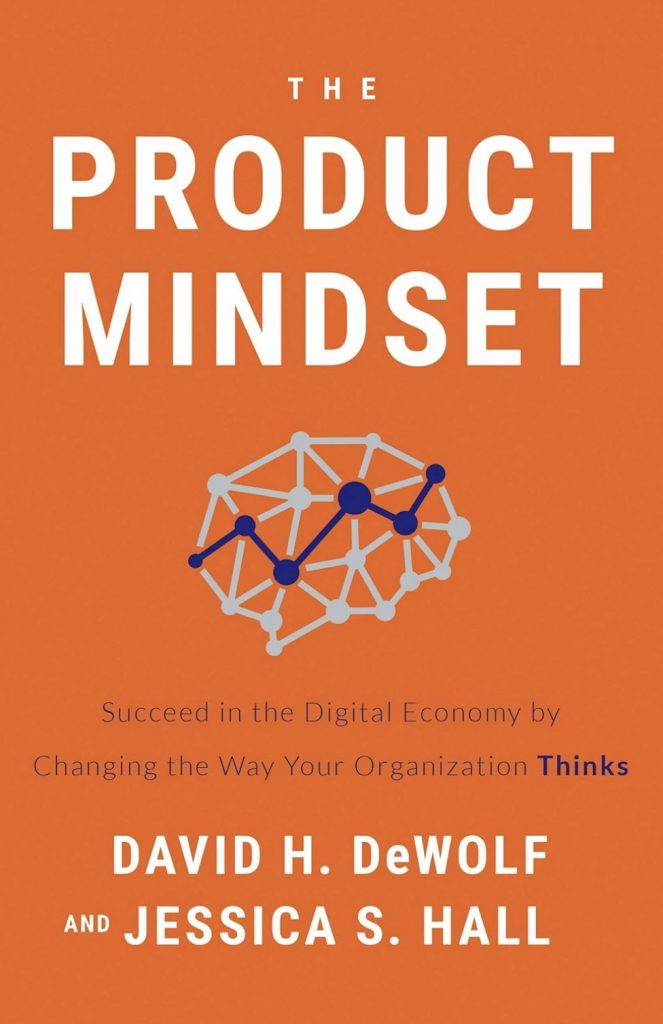Key Quote:
“Success in the digital economy means innovation. Product development is not a finite project. Your work is never done” (p. 150). — David DeWolf & Jessica Hall
Key Points and Concepts
The Product Mindset connects three characteristics of a successful digital product with three principles of successful companies (see chart below). It provides a common language and goal. This is possible through understanding the context, or the “why,” of a product. The whole team then has a clear, ultimate objective to work toward together, and they understand the market and customer for which the product was created. This approach encourages the innovation, experimentation, and communication essential to success in the digital economy.
Characteristics of a successful digital product
• The product must be self-funding
• The product must be chosen by consumers
• The product is never quite finished
Principles of a successful company
• Minimize time to value
• Solve for need
• Excel at change
Framing the Product Mindset
What is the digital economy? It’s the context for the Product Mindset. The digital economy stemmed from a fundamental shift in business models where tech became a product in its own right, not just the enabler of products (p. 40). This caused a shift from tech focused on operational efficiencies, to tech that drives revenue and business growth (p. 45). It was the consecutive advent of “the cloud, social media, and mobile computing” that catalyzed these changes (p. 44).
What is a digital product? A digital product does not have to be software. Uber, for example, is a transportation company but is based on the digital product of ride organizing software (p. 40). The new digital economy means that digital products are the goods companies are selling and without which they cannot survive.
What is a mindset? “Mindsets aren’t just beliefs. They are beliefs that orient our reactions and tendencies” (p. 64). Your mindset guides the decisions you make every day. It is your way of thinking, or your approach. Basically, your mindset is what questions you are asking.
Why the Product Mindset
The Product Mindset turns great ideas into great products, allowing companies to innovate and thrive in the digital economy.
Benefits of the Product Mindset include:
• “Improves communication and collaboration” across teams, roles, and cultures (p. 68).
• “Allows everyone to view their ultimate goal through the same lens and connects the whole organization through a shared language” (p. 69).
• “Sharpens focus, eliminates distractions,”and helps companies to “concentrate on what matters” (p. 77).
• Helps to “attract and retain talent” (p. 78).
Understanding the Product Mindset
The product must be self-funding
• A digital product’s “entire purpose is to generate the revenue stream that will pay for your ongoing development” (p. 88). This cannot happen if the product is not making money. And this cannot happen if customers cannot try it.
• You cannot wait for a product to be finished to release it to your customers. Don’t get caught up in making the perfect product and end up with nothing.
•Digital products provide near unlimited return which comes with greater risk and more experimentation and iteration (p. 89).
Minimize Time to Value
•The faster you get your product in the hands of customers, the faster you see value. “Value exists in the hands of our customers and stakeholders” (p. 98).
• Three upsides of minimizing time to value: increase efficiency, strengthen stakeholder investment, create a feedback loop (p. 100).
• Instead of waiting for a finished product to release, “solve the most important problem and do it really well” (p. 103). Then you make your product indispensable, start earning from it, and can continue to improve it, which in turn increases its value.
• “Build slices, not blocks” (p. 104). As you build a product, put pieces in one by one and change them out as needed. Don’t start at the bottom and build up one level at a time.
The Product Must Be Chosen
• Your product will only be successful if people choose to buy it.
• Think like the customer. Put yourself in their shoes and ask what would make you choose your product over another (p. 116).
• Tradeoffs customers consider in making a product choice: features vs. experience, value vs. superiority, performance vs. features, choice vs. brand loyalty (p. 117).
• Customers must pick your product continually, not choose to switch to incoming competitors. Businesses need to “anticipate the future want while meeting the present need” (p. 126).
• Factors for initial choice: social capital, barrier to start, perceived utility (p. 123).
• Factors for ongoing choice: basic needs, performance needs, delighters (p. 124).
Solve for Need
• Look at what your customer is trying to accomplish. “A successful product will help someone do the job that they can’t do today” (p. 132).
• The best way to discover needs is to talk to people. You don’t need to pay for advanced research, just get “everyone in the company in the habit of asking questions” wherever and whenever they interact with customers (p. 138).
• Four characteristics of a need: customer knows it’s a problem, customer is feeling pain, customer is trying to solve it alone, customer is willing to spend money on a solution (p. 137).
• To know if you’ve solved for need, look at adoption, engagement, referrals (p. 141).
The product is never done
• For a product to survive, it must continuously evolve and adapt; there is no end since the market and
customer needs you are targeting are always changing.
• “Success in the digital economy means innovation. Product development is not a finite project. Your work is never done” (p. 150).
• “A project mentality is counterproductive, because a digital product is never done. Customers expect ongoing evolution and improvement of their favorite products” (p. 148). Build in an ongoing monthly expense for project development rather than billing it as a one-time expense (p. 152).
Excel at Change
• Change must be fast and continuous.
• For your company to embrace change, your employees need to buy in. Some ways to help: involve them in decision making, reward experimentation, don’t be afraid to learn from how others do it (p. 159).
• Keys to excel at change: track results, communicate everything, iterate versions, be efficient, change incrementally, evaluate data, stay curious (p. 156).
• Practices to excel at change: delivery pipelines, test automation, communication to create transparency, continual adjustment of process (p. 162).
Implementing the Product Mindset
The Product Mindset applies to everyone in a company; it “must be something that everyone adopts, no matter their title or job description” (p. 169).
• Successful implementation of the Product Mindset depends on an attractive corporate culture (p. 171).
• Six critical factors: culture, feedback, communication, staffing, collaboration, time/budget focus.
• It is possible to “deliberately create (or change) the culture of your organization” (p. 174).
• Steps to influence culture: hire wisely, train current talent, define the culture you want and enforce it.
• Leadership is responsible for shaping culture. As a leader, you need to provide strategic direction, guiding principles, and an example to follow (p. 179).
Three key elements to motivate and maintain the product mindset culture: empowerment, freedom, communication.
• Empowerment: Avoid micromanaging but offer guidelines to help employees make their own decisions and exercise their influence (p. 182).
• Freedom: Employees need room to ask questions, experiment, and fail. They should not be held to one task but allowed to innovate (p. 185).
• Communication: Teams need to speak with each other to understand the bigger picture. Employees should maintain a “we” not “I” mindset (p. 186).
The product mindset works alongside all three most common methodologies: agile, design thinking, lean startup. Within each, “it offers a common vernacular and way to work together” (p. 191).
DeWolf, D. H., & Hall, J. S. (2019). The Product Mindset: Succeed in the Digital Economy by Changing the Way Your
Organization Thinks. New York: Lioncrest Publishing.

“What is the digital economy? It’s the context for the Product Mindset. The digital economy stemmed from a fundamental shift in business models where tech became a product in its own right, not just the enabler of products.”
“Customers must pick your product continually, not choose to switch to incoming competitors. Businesses need to “anticipate the future want while meeting the present need.”
“A project mentality is counterproductive, because a digital product is never done. Customers expect ongoing evolution and improvement of their favorite products.” Build in an ongoing monthly expense for project development rather than billing it as a one-time expense.”
